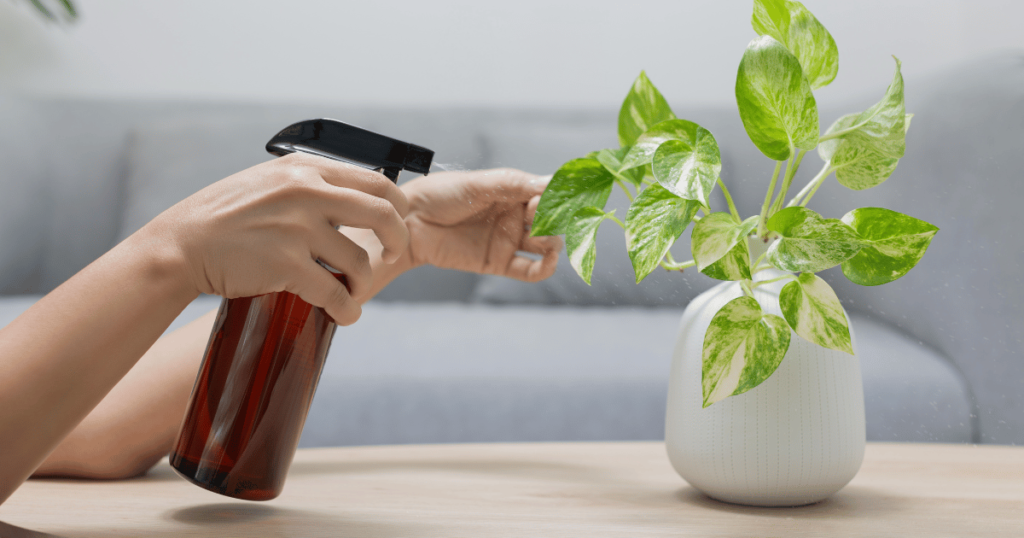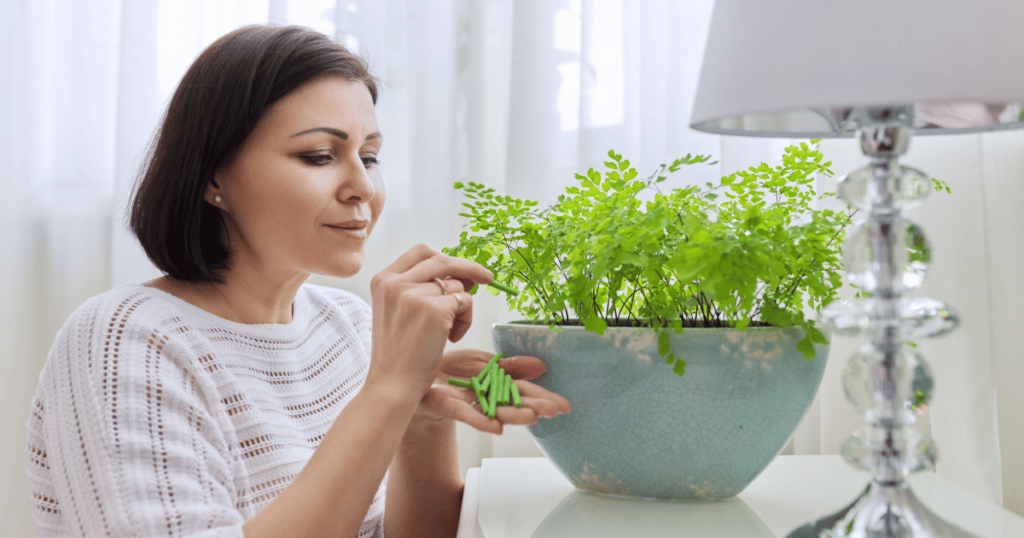As winter casts its chilly spell, houseplant enthusiasts face the dilemma of providing optimal care for their leafy companions. The colder months bring unique challenges to indoor greenery, with reduced sunlight and lower temperatures impacting plant growth. This article will explore whether you fertilize houseplants in the winter.
Navigating through misconceptions, understanding growth patterns, and exploring effective fertilization techniques, we aim to provide comprehensive insights for plant parents seeking to ensure their indoor flora thrives during the frosty season.
Join us as we uncover the secrets to maintaining vibrant and healthy houseplants amidst winter’s grasp.
Understanding Houseplant Growth Patterns
Houseplant growth patterns undergo notable changes, particularly when winter sets in. Understanding these shifts is pivotal for effective plant care. As the days shorten and temperatures drop, houseplants enter a phase of reduced metabolic activity. The diminished sunlight during winter impacts photosynthesis, slowing down growth. This dormancy period is a survival mechanism, allowing plants to conserve energy. Consequently, nutrient requirements decrease. Recognizing these natural cycles helps plant enthusiasts tailor their care routines.
Comprehending houseplant growth patterns enables one to make informed decisions regarding fertilization, watering, and overall winter maintenance, ensuring indoor green companions’ well-being.
Why are my indoor plants dying in winter?

As the winter chill settles in, indoor plant enthusiasts may encounter challenges leading to the decline of their green companions. Several factors contribute to the struggle of indoor plants during this season. Firstly, reduced daylight hours limit photosynthesis, slowing down metabolic processes crucial for plant growth. Inadequate light can result in weakened plants with pale, stretched-out foliage. Additionally, the low humidity common in winter and artificial heating indoors can lead to dry conditions, affecting the moisture balance essential for plant health.
Overwatering, a common pitfall, becomes more prevalent as the slower growth rate in winter reduces the plant’s water requirements. Soil that remains consistently wet can lead to root rot and other moisture-related issues. Furthermore, drafts from windows or doors can expose plants to temperature fluctuations, causing stress and negatively impacting their overall vigour.
To mitigate these challenges, consider relocating plants to areas with better light exposure, adjusting your watering routine to the plant’s reduced needs, and providing supplementary humidity. Insulate plants from drafts, and avoid placing them near heat sources. Understanding and addressing these winter-specific issues can help rejuvenate your indoor garden, ensuring your plants survive and thrive through the colder months.
The Role of Fertilization
Fertilization is a cornerstone in houseplant care, which is pivotal in sustaining plant health. Like any living organism, plants rely on essential nutrients for their growth and well-being. These nutrients, including nitrogen, phosphorus, and potassium, are vital building blocks for various physiological processes within the plant.
Fertilizers are a nutrient source, supplying plants with the necessary elements to thrive. Nitrogen aids leaf development, phosphorus supports root growth, and potassium contributes to plant vigour. As winter ushers in conditions that may limit nutrient availability, understanding the significance of fertilization becomes paramount in ensuring the health and resilience of your cherished houseplants.
How often do you fertilize indoor plants in winter?

How often you fertilize indoor plants in winter depends on several factors, including the type of plants, the fertilizer used, and environmental conditions. Here are key points to consider:
- Plant Type:
- Different houseplants have varying nutritional needs. Some may require more frequent fertilization, while others thrive with less frequent doses.
- Fertilizer Type:
- Choose a fertilizer with a balanced N-P-K ratio suitable for winter use. Slow-release fertilizers are often preferred, as they provide a steady supply of nutrients over an extended period.
- Plant Dormancy:
- Recognize that many plants experience a period of dormancy in winter. Their metabolic activity slows during this time, and they may require fewer nutrients. Adjust the frequency accordingly.
- Soil Moisture:
- Fertilize when the soil is moist but not soggy. Applying fertilizer to dry soil or overwatered soil can hinder nutrient absorption.
- Observation:
- Monitor your plants for signs of nutrient deficiency, such as yellowing leaves or stunted growth. If these symptoms appear, consider increasing the frequency of fertilization.
- Manufacturer’s Recommendations:
- Refer to the instructions on the fertilizer packaging. Manufacturers often provide guidelines on how frequently to apply their product based on the plant type and season.
- Avoid Over-Fertilizing:
- Over-fertilizing can harm plants. Stick to the recommended dosage and frequency to prevent nutrient imbalances that may negatively impact indoor plants.
- Consider Alternatives:
- Explore natural alternatives like compost or organic fertilizers, which may require different application frequencies than synthetic fertilizers.
Common Misconceptions about Winter Fertilization
Common misconceptions often surround the practice of fertilizing houseplants during the winter, leading to confusion among plant enthusiasts. One prevalent myth is the belief that plants enter a complete dormancy, rendering them unresponsive to fertilization. Contrary to this notion, while winter may induce a slower growth rate, plants still require essential nutrients for sustaining overall health.
Another misconception is the fear of overstimulating plants during their supposed rest period, leading to potential harm. Judicious and well-timed fertilization can bolster a plant’s resilience, preparing it for robust growth when spring arrives. Addressing these myths is crucial to dispel unwarranted concerns, allowing plant parents to adopt informed and effective winter fertilization practices that cater to the unique needs of their leafy companions.
Types of Fertilizers
Types of Fertilizers: Overview of Suitable Options for Winter Use
Choosing the right fertilizer is crucial for maintaining the health of your houseplants during the winter months. Here’s an overview of suitable fertilizers tailored for winter use:
Balanced Fertilizers:
Fertilizers with a balanced N-P-K ratio (nitrogen, phosphorus, and potassium) provide essential nutrients in proportions suitable for overall plant health.
Slow-Release Fertilizers:
Ideal for winter, slow-release fertilizers give a steady supply of nutrients over an extended period. This gradual release aligns with the slower metabolic activity of plants during the colder season.
These are quick-acting and easily absorbed by plant roots. They can be diluted and applied during the winter, ensuring a faster nutrient boost.
Organic Fertilizers:
Compost, worm castings, and organic blends offer a natural alternative. They contribute to soil health and provide a spectrum of nutrients without the risk of over-fertilization.
Winter-Formulated Fertilizers:
Some brands offer formulations specifically designed for winter use. These may contain additional micronutrients that support plant resilience in colder conditions.
Low-Nitrogen Fertilizers:
As plants require less nitrogen in winter, opting for a fertilizer with lower nitrogen content prevents excessive foliage growth and promotes overall plant balance.
Dos and Don’ts of Winter Fertilization

Dos and Don’ts of Winter Fertilization:
Winter fertilization demands a nuanced approach to ensure the health of your houseplants. Here are some dos and don’ts to guide you through adequate fertilization during the colder months:
Dos:
Choose a Balanced Fertilizer:
Opt for a fertilizer with a balanced N-P-K ratio suitable for winter use. This ensures a comprehensive supply of essential nutrients without promoting excessive foliage growth.
Use Slow-Release Fertilizers:
Consider slow-release fertilizers that provide a steady nutrient release over an extended period. This helps sustain your plants without the risk of over-fertilization.
Apply Diluted Solutions:
Dilute your fertilizer according to the recommended dosage. Applying a concentrated solution can lead to nutrient imbalances, potentially harming your plants.
Water Before Fertilizing:
Ensure the soil is adequately moist before applying fertilizer. Fertilizing dry soil can hinder nutrient absorption, while overwatered soil may lead to nutrient leaching.
Monitor Plant Responses:
Regularly observe your plants for signs of nutrient deficiency or excess. Adjust your fertilization routine based on each plant’s specific needs and responses.
Don’ts:
Avoid Over-Fertilizing:
Please resist the temptation to over-fertilize, thinking it will compensate for winter dormancy. Too much fertilizer can harm plants, causing nutrient imbalances and potential damage.
Skip Fertilization Entirely:
While plants may experience reduced growth in winter, skipping fertilization is not advisable. A moderate nutrient boost helps plants maintain health and prepare for the growing season.
Use High-Nitrogen Fertilizers:
Steer clear of fertilizers with high nitrogen content, as they can promote excessive foliage growth at the expense of overall plant health. Choose a balanced fertilizer to support a more holistic growth approach.
Neglect Individual Plant Needs:
Recognize that different houseplants have varying nutritional requirements. Tailor your fertilization routine to the specific needs of each plant rather than adopting a one-size-fits-all approach.
Signs Your Houseplants Need Fertilizing
Recognizing when your houseplants need fertilizing is crucial for maintaining their health and promoting optimal growth, especially during winter. Here are key signs that indicate it’s time to provide a nutrient boost to your indoor greenery:
Yellowing Leaves:
It may signal a nutrient deficiency if you notice yellowing leaves, particularly the older ones. Fertilization can rectify this issue by supplying the necessary elements for chlorophyll production.
Stunted Growth:
Slow or stunted growth, compared to the plant’s typical rate, is a clear indication that it may need additional nutrients. Fertilizing can stimulate growth and support overall plant vitality.
Poor Flowering or Fruit Production:
Houseplants that usually produce flowers or fruits but exhibit a decline in these processes may lack essential nutrients. Fertilizing can enhance flowering and fruiting capabilities.
Pale or Discolored Foliage:
Discoloration in leaves, such as a pale or mottled appearance, suggests nutrient deficiencies. Fertilization provides the necessary elements to maintain vibrant and healthy foliage.
Leaf Drop:
If your houseplant is shedding leaves excessively, it could be a response to insufficient nutrients. Fertilizing can help stabilize the plant and reduce leaf loss.
Deteriorating Soil Quality:
Over time, the nutrients in the soil may be depleted, especially in container plants. Regularly fertilizing replenishes the soil, ensuring a nutrient-rich environment for your plants.
Read to know about: Can I Use Outdoor Soil for Indoor Plants? Safe planting
Increased Pest Susceptibility:
Weakened plants are more susceptible to pests. Observing an uptick in pest activity may indicate nutrient deficiencies that can be addressed through fertilization.
Previous Fertilization Was Several Weeks Ago:
Consider the last time you fertilized your houseplants. If it has been several weeks or months, it might be time to provide another round of nutrients, especially in the active growing season.
Seasonal Changes:
As winter transitions into spring, plants may require an extra nutrient boost to support the upcoming growth phase. Observing the changing seasons and adjusting fertilization accordingly is essential.
Overall Decline in Plant Health:
A general decline in the plant’s health, including wilting, drooping, or lacklustre appearance, could be an overarching sign that it needs additional nutrients to thrive.
When should I stop fertilizing my houseplants?
Knowing when to stop fertilizing your houseplants is as crucial as understanding when to start. Here are key considerations to guide you:
Winter Dormancy:
As winter approaches, many houseplants enter a period of dormancy characterized by reduced growth. During this time, it’s advisable to taper off fertilization. Most plants require fewer nutrients in winter, and over-fertilizing can lead to nutrient imbalances.
Reduced Daylight Hours:
Shorter daylight hours in winter result in decreased photosynthesis and metabolic activity. With the plant’s diminished need for nutrients, reducing or suspending fertilization during this period is wise.
Observing Plant Growth:
Monitor your houseplants closely. If you observe slowed or halted growth, it may indicate that the plant is entering a dormant phase, and fertilization can be paused until signs of active growth reappear.
Species-Specific Cycles:
Different houseplants have distinct growth cycles. Some may exhibit active growth year-round, while others may have distinct dormancy periods. Familiarize yourself with the specific needs of each plant species to determine the appropriate fertilization schedule.
Adjusting for Seasonal Changes:
Resume fertilization in spring as daylight hours increase and plants naturally enter a period of active growth. This is an opportune time to provide the nutrients needed for robust development.
Soil Quality and Nutrient Levels:
Regularly assess the quality of the soil and nutrient levels. If the soil is rich and your houseplants show signs of vitality, you may need to fertilize less frequently or not at all for a certain period.
Plant Age and Health:
Consider the age and health of your houseplants. Younger, rapidly growing plants may benefit from more frequent fertilization, while mature or slow-growing plants may require less.
Avoiding Nutrient Buildup:
Over time, continuous fertilization can lead to a buildup of salts and minerals in the soil, potentially causing harm to your plants. Periodic flushing of the soil with water can help prevent nutrient accumulation.
Following Fertilizer Instructions:
Adhere to the guidelines provided on the fertilizer packaging. Manufacturers often offer recommendations on the frequency of application. Following these guidelines helps prevent over-fertilization.
Environmental Factors:
Consider external factors such as temperature, humidity, and light levels. If your houseplants are exposed to low light or cooler temperatures during winter, they may require less fertilizer.
Alternatives to Traditional Fertilizers
In pursuing sustainable and eco-friendly plant care, consider alternatives to traditional fertilizers. Organic choices, such as compost, worm castings, and seaweed extracts, offer a wealth of nutrients while enhancing soil structure. These natural alternatives provide essential elements for plant growth and contribute to overall soil health. By incorporating these organic options, you promote a balanced and environmentally conscious approach to nurturing your houseplants.
Adjusting Fertilization Frequency
Tailoring your fertilization frequency is a nuanced practice that involves understanding the diverse needs of various houseplant species. Recognize that each plant has its unique nutritional requirements. Some may thrive with more frequent, diluted applications, while others benefit from a less frequent but more concentrated nutrient regimen. By adapting your fertilization routine based on individual plant characteristics, you ensure each houseplant receives the precise nourishment required for optimal growth and vitality.
Winterizing Houseplants Beyond Fertilization
Winterizing your houseplants involves a holistic approach that extends beyond fertilization. In the colder months, addressing multiple aspects of plant care is essential to ensure their well-being. Proper watering, humidity control, and protection from drafts are integral components of winter plant care. Creating a conducive environment that considers these factors enhances your indoor garden’s overall health and resilience. By embracing a comprehensive winterization strategy, you provide your houseplants with the best conditions to thrive during the challenging winter season.
Conclusion
In conclusion, fertilizing houseplants in winter is not a one-size-fits-all approach. Understanding the unique needs of your plants, choosing the right fertilizer, and adjusting your care routine can make a significant difference. Winter should be a time of preparation, ensuring your houseplants emerge from dormancy and are ready to thrive in spring.
FAQs
Can I use the same fertilizer for all my houseplants in winter?
A: While a balanced fertilizer is generally suitable, it’s essential to consider the specific needs of each plant. Adjust the fertilizer type and frequency based on individual requirements.
Is it possible to over-fertilize houseplants in winter?
A: Yes, over-fertilizing can harm plants. It’s crucial to follow recommended dosage instructions and pay attention to signs of nutrient deficiency or excess.
Are there natural alternatives to synthetic fertilizers for winter use?
A: Absolutely! Compost, worm castings, and seaweed extracts are excellent organic options that provide essential nutrients without synthetic additives.
Should I water my houseplants differently when fertilizing in winter?
A: Proper watering is crucial. Ensure the soil is moist before applying fertilizer, and avoid overwatering to prevent nutrient leaching.
Can I use leftover garden fertilizer for my houseplants in winter?
A: It’s not recommended. Garden fertilizers may not provide the balanced nutrients houseplants need, and the dosage may be too high. Opt for a fertilizer specifically formulated for indoor plants.







